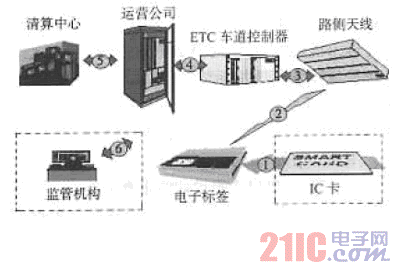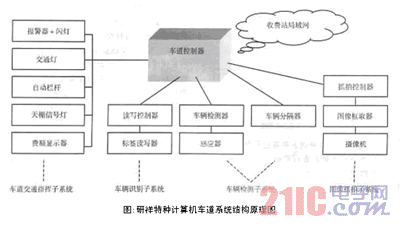Design and Implementation of a Highway Non-stop Charging System
1 Overview
This article refers to the address: http://
The non-stop charging system is also known as the Electronic Collection System (ECC). It uses the vehicle automatic identification technology to complete the wireless data communication between the vehicle and the toll station, carries out the automatic identification of the vehicle and exchanges the relevant charging data, and processes the charging data through the computer network to realize the electronic charging management system for automatic charging without parking. . The system uses the computer networking technology to perform background settlement with the bank through microwave-specific short-range communication between the vehicle active electronic tag mounted on the windshield of the vehicle or other parts of the vehicle body and the remote reader/writer on the ETC lane of the toll station. Processing, so as to achieve the purpose of the vehicle to pay the road and bridge fees through the road and bridge toll station without parking. The non-stop charging system mainly utilizes the vehicle automatic identification technology, and the signal transmission and receiving device of the roadside lane control system recognizes the number passing through the vehicle, and automatically deducts the toll from the user's special account.

The system collects the information of the radio frequency card through long-distance and non-contact, realizes the automatic identification of the vehicle in the fast moving state, thereby realizing the automatic management of the target. The system integrates computer software and hardware, wireless communication, information collection and processing, data transmission, network communication, automatic control and smart card production, and is an advanced intelligent traffic information collection device and a high-security intelligent identification system. It is an important technical means to effectively identify and supervise vehicles. In terms of current technical means, only active electronic tags can achieve stable high-speed identification. The Bisa long-distance reader can read up to 100 meters and the reading reliability reaches 100%.

2. Technical system composition
2.1 System composition of the non-stop charging system
The ETC system is mainly composed of ETC toll lanes, toll station management system, ETC management center, professional bank and transmission network. According to the division of labor, the system can be divided into two parts: the foreground and the background. The front desk is centered on the lane control subsystem, which is used to control and manage the communication between various external field devices and electronic tags installed on the vehicle, record various information of the vehicles, and transmit them to the toll booth management subsystem in real time; Management subsystem, ETC management center and professional banks. The ETC Management Center is the top management of the ETC system. It requires the processing and exchange of charging information and data, as well as the necessary management functions. It includes the toll franchisees, settlement centers and customer service centers of various highways. The background is based on the received data files for transaction, debit and financial settlement between the highway toll franchise company and the user, and is equipped with multiple powerful computers to complete the collection and processing of various data and images in the system. Figure 1 is a schematic diagram of an electronic toll collection system.
2.2, hardware system composition
The non-stop charging hardware system includes a data collection part of the toll station, a data transmission part, and a monitoring management part. The data collection equipment of the toll station is mainly the time and place information of the long-distance non-contact collection vehicle. The toll station data collection device consists of several toll stations that form the local area network. Each toll station is equipped with the following equipment:
(1) Remote reader
(2) Actuator controller (for controlling cameras, traffic lights, alarms, etc.)
(3) camera
(4) Traffic lights
(5) Alarm
(6) Lane industrial computer
(7) Uninterruptible Power Supply
Among them, the lane industrial computer adopts the EVOC dedicated lane industrial computer (redundant power supply) developed by EVOC for the ETC system. The specifications are as follows:
Full-length CPU card for Intel 965 chip
CPU: Core Duo
1 10/100/1000 M Mbps adaptive Ethernet interface;
Digital quantity: standard, 8 input, 8 output;
Serial communication port: 6 standard, scalable.
Video interface: 1 road sign;
Character adder
Vehicle detector
Power module: AC redundant 220V input DC 5V, 12V, 24V output switching power supply, with overvoltage and overcurrent protection
Circuit protection: air leakage protection lightning protection.
With its high adaptability and stability, the EVOC dedicated lane industrial computer adapts to environmental factors such as highway pollution, dust and electromagnetic interference, which ensures the accuracy and system stability of ETC system information collection. At the same time, its high computing performance, large storage capacity, and better adapted to tell the highway toll system is busy, the data transmission is large.
3. Application project: The project has opened a precedent in the Shanghai area and is of great significance.
In the context of the continuous increase in the traffic volume of highways and highways, and the increasing congestion of highway toll stations, especially the main toll stations, the Shanghai Construction and Transportation Department has defined the overall goal of highway ETC system construction and vigorously promoted the development of ETC systems. The process is to strive to achieve full coverage of the crossing. At present, in the toll stations and lanes that have been put into use, the EVOC special computer covers A9 (Hu Qingping), A8 (Shanghai-Hangzhou), A2 (Shanghai-Chongqing), A4 (莘Fengjin), A5 (Shanghai Gold), A30 (Northern Ring, Tongsan, South Ring, Southeast Ring) and many other Shanghai-related expressways.
A heat pipe radiator is a heat transfer element with extremely high thermal conductivity, which transfers heat through the evaporation and condensation of liquid in a fully enclosed vacuum tube. Most of these fans have the characteristics of "air cooling+heat pipe", which combines the advantages of air cooling and heat pipe, and has extremely high heat dissipation
Heat pipe
Guangzhou Lufeng Electronic Technology Co. , Ltd. , https://www.lufengelectronics.com